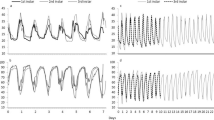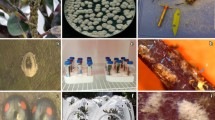Abstract
The susceptibility of larvae ofThaumetopoea solitaria Freyer (Lepidoptera; Notodontidae, Thaumetopoeinae), fed on treated pistachio foliage, to three commercial control products derived fromBacillus thuringiensis (Bt), was evaluated in the laboratory. Both Dipel DF and Delfin WG were highly effective against 1st and 2nd instar larvae at relatively low concentrations (LC50: 0.01–0.04%), whereas mortality of the 3rd instar larvae reached 50% only at a Dipel DF concentration of 0.2%. The third formulation, Foray 48B, was significantly less toxic toward all tested larval instars. The susceptibility ofT. solitaria toBr decreased progressively between molts, and then increased steeply during the first days following each molt. Use of the film-forming polymer Nu-Film as a wetting agent and spreader-sticker for the commercial formulation of Dipel DF improvedBt adhesion to extremely hydrophobic youngPistacia foliage, and significantly increasedBt persistence under ambient conditions. Addition of Nu-Film improved the leaf surface coverage and extended the duration of rainproofing.
Similar content being viewed by others
References
Battisti, A., Longo, S., Tiberi, R. and Triggiani, O. (1998) Results and perspectives in the use ofBacillus thuringiensis Berl. var.kurstaki and other pathogens againstThaumetopoea pityocampa (Den. et Schiff.) in Italy (Lep., Thaumetopoeidae).Anz. Schaedlkd. Pflanzenschutz Umweltschutz 71:72–76.
Bauce, E., Bidon, Y. and Berthiaume, R. (2002) Effects of food nutritive quality andBacillus thuringiensis on feeding behaviour, food utilization and larval growth of spruce budwormChoristoneura fumiferana (Clem.) when exposed as fourth- and sixth-instar larvae.Agric. For. Entomol. 4:57–70.
Baur, M.E., Kaya, H.K., Gaugler, R. and Tabashnik, B. (1997) Effects of adjuvants on entomopathogenic nematode persistence and efficacy againstPlutella xylostella, Biocontrol Sci. Technol. 7:513–525.
Behle, R.W., McGuire, M.R. and Shasha, B.S. (1997) Effects of sunlight and simulated rain on residual activity ofBacillus thuringiensis formulations.J. Econ. Entomol. 90:1560–1566.
Brar, S.K., Verma, M., Tyagi, R.D. and Valero, J.R. (2006) Recent advances in downstream processing and formulations ofBacillus thuringiensis based biopesticides.Proc. Biochem. 41:323–342.
Brar, S.K., Verma, M., Tyagi, R.D., Valero, J.R. and Surampalli, R.Y. (2006) Screening of different adjuvants for wastewater/wastewater sludge-basedBacillus thuringiensis formulations.J. Econ. Entomol. 99:1065–1079.
Davatchi, A.G. (1958) Etude biologique de la faune entomologique des Pístacía sauvages et cultívés.Rev. Pathol. Veg. Entomol. Agric. Fr. 37:49–52 (abstr.).
Farrar, R.R., Martin, P.A.W. and Ridgway, R.L. (1996) Host plant effect on activity ofBacillus thuringiensis against gypsy moth (Lepidoptera: Lymantriidae) larvae.Environ. Entomol. 25:1215–1223.
Gindin, G., Navon, A., Protasov, N., Saphir and Mendel, Z. (2007) Differing susceptibility toBacillus thuringiensis formulations ofThaumetopoea wilkinsoni populations between forests with differentBt management in Israel.Phytoparasitica 35:179–190.
Gindin, G., Navon, A., Saphir, N., Protasov, A. and Mendel, Z. (2007) Environmental persistence ofBacillus thuringiensis products tested under natural conditions againstThaumetopoea wilkinsoni.Phytoparasitica 35:255–263.
Halperin, J. (1983)Thaumetopoea solitaria Freyer (Lepidoptera: Thaumetopoeidae) in Israel.Phytoparasitica 11:71–82.
Kao, S.S., Hsia, W.T. and Huang, L.H. (1991) Effectiveness of adjuvants for nuclear polyhedrosis virus against the beet armyworm,Spodoptera exigua (Lepidoptera: Noctuidae).Clin. J. Entomol. 11:330–334.
Kubilay, M.E.R., Karadag, S. and Matt, C. (2007) Effectiveness ofBacillus thuringiensis var.kurstaki onThaumetopoea solitaria Frey. (Lepidoptera: Thaumetopoeidae) larvae in laboratory conditions.Turk. J. Agric. For. 31:255–261.
Liu, B., Zhu, Y.J. and Sengonca, C. (2006) Laboratory studies on the effect of the bioinsecticide GCSC-BtA on mortality and feeding of diamondback mothPlutella xylostella L. (Lepidoptera: Plutellidae) larvae on cabbage.J. Plant Dis. Prot. 113:31–36.
Mansfield, S., Withers, T.M., Gous, S.F., Potter, K.J.B., Kriticos, D.J., Watson, M.C.et al. (2006) Potential of selective insecticides for managingUraba lugens (Lepidoptera: Nolidae) on eucalypts.J. Econ. Entomol. 99:780–789.
Mart, C., Uygun, N., Altin, M., Erkilc, L. and Bolu, H. (1995) General review on the injurious and beneficial species and pest control methods used in pistachio orchards of Turkey.Acta Hortic. 419:379–385.
McGuire, M.B., Shasha, B.S., Eastman, C.E. and Oloumi-Sadeghi, H. (1996) Starch- and flour-based sprayable formulations: effect on rainfastness and solar stability ofBacillus thuringiensis.J. Econ. Entomol. 89:863–869.
Meade, T. and Hare, J.D. (1993) Effects of differential host plant consumption bySpodoptera exigua (Lepidoptera: Noctuidae) onBacillus thuringiensis efficacy.Environ. Entomol. 22:432–437.
Mourikis, P.A., Tsourgianni, A. and Chitzanidis, A. (1998) Pistachio nut insect pests and means of control in Greece.Acta Hortic. 470:604–611.
Mulrooney, J.E. and Elmore, C.D. (2000) Rainfastening of bifenthrin to cotton leaves with selected adjuvants.J. Euviron. Qual. 29:1863–1866.
Rausell, C., Martinez-Ramirez, A.C., Garcia-Robles, I. and Real, M.D. (2000) A binding site forBacillus thuringiensis Cryl Ab toxin is lost during larval development in two forest pests.Appl. Environ. Microbiol. 66:1553–1558.
Roversi, P.F., Faggi, M. and Rumine, P. (2005)Bacillus thuringiensis var,lurstaki againstThaumetopoea processionea L.: field trials inQuercus cerris L. woods.IOBC WPRS Bull. 28:203–210.
SAS Institute (2002) SAS/STAT User’s Guide, version 6. 11. SAS Institute, Cary, NC, USA. Vols, 1+2.
Tounou, A.K., Gounou, S., Borgemeister, C., Goumedzoe, Y.M.D. and Schulthess, F. (2005) Susceptibility ofEldana saccharina (Lepidoptera: Pyralidae),Busseola fusca, andSesamia calamistis (Lepidoptera: Noctuidae) toBacillus thuringiensis Cry toxins and potential side effects on the larval parasitoidCotesia sesamiae (Hymenoptera: Braconidae).Biocontrol Sci. Teclmol. 15:127–137.
van Frankenhuyzen, K. (1990) Effect of temperature and exposure time on toxicity ofBacillus thuringiensis Berliner spray deposits to spruce budworm,Choristoneura fumiferana Clemens (Lepidoptera: Tortricidae).Can. Entoinol. 22:69–75.
van Frankenhuyzen, K. and Nystrom, C. (1989) Residual toxicity of a high-potency formulation ofBacillus thuringiensis to spruce budworm (Lepidoptera: Tortricidae).J. Econ. Entomol. 82:868–872.
Wirth, W., Storp, S. and Jacobsen, W. (1991) Mechanisms controlling leaf retention of agricultural spray solutions.Pestic. Sci. 33:411–420.
Wright, J.E. and Chandler, L.D. (1992) Development of a biorational mycoinsecticide:Beauveria bassiana conidial formulation and its application against boll weevil populations (Coleoptera: Curculionidae).J. Econ. Entomol. 84:1130–1135.
Zar, J.H. (1984) Biostatistical Analysis. Prentice-Hall Inc, Englewood Cliffs, NJ, USA.
Zumreoghu, A. and Ulu, O. (1992) Spraying experiment against the pistacia budworm (Thaumotopoea solitaria Frey.) in the Aegean region.Zirai Mucadele Arastirma Yllg. [Plant Prot. Res. Ann.] 22–23:53–54.
Author information
Authors and Affiliations
Corresponding author
Rights and permissions
About this article
Cite this article
Gindin, G., Kuznetsova, T., Protasov, A. et al. Susceptibility of the pistachio processionary mothThaumetopoea solitaria to threeBacillus thuringiensis products. Phytoparasitica 36, 472–482 (2008). https://doi.org/10.1007/BF03020293
Received:
Accepted:
Issue Date:
DOI: https://doi.org/10.1007/BF03020293




